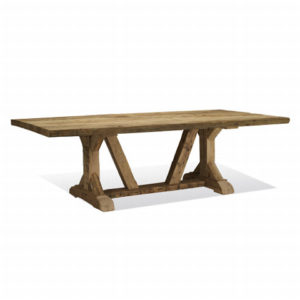Hello John,
I have been asked to bid a Trestle type solid linear Q.S. White Oak table @ 4′ x 9′ with a roughly 2 to 3″ running length wise thick plank top, possibly with bread board ends.
The design issue I am confronted with is that they want it expandable and yet to keep it looking right in my mind I can’t see it with a split in the middle. So the real question is, is there a reasonable way to add leaves to the ends of the table as opposed to the middle, (storing leaves seperately), without ruining the aesthetics of this classic design and yet making it functional, reliable and sag resistant. I was not planning on running an apron as it doesn’t necessarily go with this heavy rustic stlyle.
Seperate legs on the end leaves would not jive with the design.
I realize that the leaves would be really heavy if made in suit with table top. Perhaps I could make them hollow box style, (bottomless) and with legs and be done with it, but I am not giving up that is why I am asking you.
The only other thought I have is to have pegs in the leaves that sink into mortises in the main top, but there will be deffinitely be sag and difficult to mortise deep enough in solid wood.
My last idea is to have hidden support runners that extend from under the main table and somehow lock in to the leaves, with hardware or dovetail key etc…
Any ideas? Have you ever seen this type of expansion table?
The Trestle table in the photo is odd because of the diagonal braces that aren’t necessary but could be more so if they were reversed. This is just an example photo.
Thank you
















Replies
Trestle Design
It seems that if you use a wide breadboard end, 18", you could have each b.b.end slide out using table top sliding hardware and index everything with dowels and holes (bb ends to table...leaves to table and bb ends). With a table at 48" wide, the trestles could be near the bb end/table joint and in the closed position provide seat for two at each end. I think the leaves would have to be limited to about 10" in width which means that you would gain seating for one on each side (20" added to the length of the table). At 4ft by 9 ft I see seating two at each end and three on each side for a total of ten people. With two ten inch wide leaves you could add seating for two to each side for a total of twelve. If the design were sort of thick and rustic, V-grooves at the planks and bb ends would held disguise the table-to-bb end break.
Good slides would be inportant..just my thoughts
Ross
This forum post is now archived. Commenting has been disabled